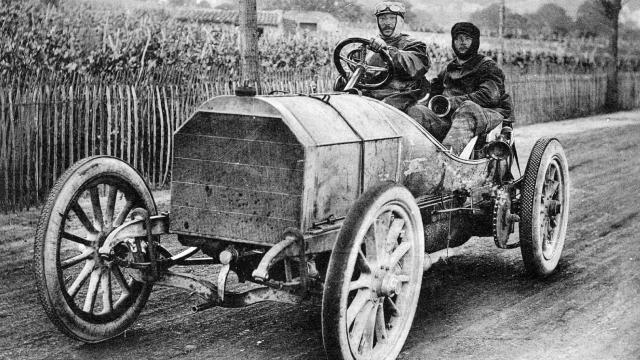On November 22, 1900, entrepreneur Emil Jellinek took his specially-crafted Daimler-Motoren-Gesellschaft machine out for a test drive. It was lighter, sleeker, and faster than anything the company had made before, and to honour the occasion, the car was named Mercedes after Jellinek’s daughter.
Automotive historians recognise that car as being the first proper Mercedes. DMG had made four-wheeled machines powered by an engine before, but the special build instructions from Jellinek saw the Mercedes as a more formidable force to be reckoned with.
Jellinek was something of a car salesman. He’d been buying Daimler’s cars in the late 1890s with the intention of selling them to his friends, but at that point, they weren’t exactly ultra-fast. They were winning races, yes — Jellinek liked to enter them under his daughter’s name when competing — but back then, 24 km/h was blindingly fast.
Here’s what the state of Georgia’s Court of Appeals had to say about cars in the early 1900s: “Automobiles are to be classed with ferocious animals and … the law relating to the duty of owners of such animals is to be applied … . However, they are not to be classed with bad dogs, vicious bulls, evil disposed mules, and the like.” When the first gasoline-powered car hit the streets of Detroit just before the turn of the century, newspapers described it as “tearing along the street at a lively rate, dodging people and teams.” What seems slow to us now was faster than anything the average person had ever seen before in 1900.
Jellinek’s handcrafted Daimler had 26 kW, which was frankly sensational at the time. Here’s more from Daimler:
Its front-mounted four-cylinder in-line engine was bolted directly to the new, pressed-steel frame and had the sensational output of 35 hp (26 kW). The engine speed was regulated between 300 and 1000 rpm by a lever on the steering wheel. The cylinders and cylinder head formed a single unit and for the first time the crankcase was made of aluminium. The power-to-weight ratio was now only 6.6 kilograms per hp, and one year later it fell to just 4.6 kg/hp. The intake valves were no longer controlled automatically, but by camshaft, like the exhaust valves.
The car featured a spray-nozzle carburetor, honeycomb radiator, cooling fan, gear-type oil pump, water pump and magneto ignition. Equally new features of the car included a very compact, self-adjusting spring-band clutch, a single gearshift lever moving in a gate to operate the four-speed transmission, and a heavily inclined steering column.
These were all pretty revolutionary in 1900. The Mercedes had a wider wheelbase, which made it far more stable than its predecessors, and more powerful drum brakes were added to counter all that newfound power. It was designed to be the fastest thing on a race course, and it kicked off an era of Mercedes success that lasted until the marque withdrew from motorsport in 1955
When I told my husband what I was writing about this morning, he said, “Oh, you mean the first car.” Yes, he’s being a little cheeky as a former Mercedes salesman — but he’s also not totally wrong. DMG was doing some really fascinating stuff with its cars, and in true European style, was willing to work with the ultra-rich to develop bespoke machines that pushed the boundaries of what folks at the time knew cars to be. Compare that to the American model, where someone like Henry Ford found a formula that worked for a car and sold that exact version to everyone it possibly could. DMG was far more willing to work directly with someone who wanted to do something a little out there.
And it paid off. In the grand scheme of Jellinek’s life, this little outing behind the wheel of his new car was probably exciting, but it’s hard to imagine he knew his request was about to change the faces of both the automotive industry and the racing world. And yet that’s exactly what happened. The Mercedes name was officially registered in 1902, and DMG adopted it, beginning a legacy of luxurious speed machines that continues to this day.
